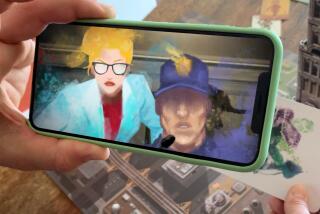This ‘Life’ Not Worth Living Without People
- Share via
Like life itself, playing “The Game of Life” used to mean interacting with others. Everybody gathered around the board, which had colorful money stuffed under its edges, as plastic cars carrying pink and blue pegs navigated a plastic landscape.
The game was and remains a simple capitalistic trip through the decades. The player who made it to the end with the most money won--a perfect metaphor for postwar America.
And, perhaps without meaning to, “The CD-ROM Game of Life” from Hasbro Interactive is the perfect metaphor for virtual America. It is possible--indeed, preferable--to play the game completely alone.
Don’t worry. The program drives the cars through the landscape, just like your kid brother used to. It makes wisecracks, just like your dad used to. And the electronic opponents wrinkle their brows at every setback, just like your mom used to.
Except Mom, Dad and little brother could just as well be in the next state as in the next room. For some families, that may be a blessing. But overall, “The CD-ROM Game of Life” is missing the ingredient that makes its non-digital incarnation--not to mention its real-life inspiration--so interesting, so frustrating and ultimately so enjoyable.
Other people.
“The Game of Life” is a household icon because it brought families and friends together for a simple game that no one had to think too much about. Life itself unfolded as “The Game of Life” was being played. Jokes were told, days recounted.
It may be possible with “The CD-ROM Game of Life,” but it’s a lot more difficult. I just can’t imagine the family abandoning the kitchen table to fan out around the computer monitor. Clicking a virtual spinner is not the same as giving the real thing a good quick flick of the wrist.
Hasbro Interactive has made big business in recent months by repackaging classic games as CD-ROM or console fare. Technically, the games are great. “The CD-ROM Game of Life” does a beautiful job of re-creating the kitsch of the original. But spiritually, the games lack.
There are video games, and there are board games. They are different creatures. Keep them separate.
‘G Darius’
Fast. There’s no other way to describe “G Darius,” a Sony PlayStation shooter that pits players against an alien onslaught. This is the kind of action console owners expect from their rigs. There’s not much to it: Shoot and dodge the attacks of others. So simple. So fast. So sweet.
‘Return Fire 2’
It’s tough to understand the significance of “Return Fire” unless you were one of the 14 or so people who owned a 3DO Multiplayer. For the longest time, it was the single game that prevented 3DO owners from feeling like total idiots for shelling out $700.
It was, quite simply, a beautiful game--an apocalyptic symphony. The sequel tries to capture some of the original’s panache in a PC incarnation that, like the original 3DO version, is beyond the reach of most players.
Just to get the game to run, players need at least a Pentium 133 with a 3-D accelerator card. Optimal setup is a Pentium 200 MMX, 32 megabytes of RAM and a 3Dfx accelerator. I played on a Pentium II 333 with 64mb of RAM and a 4mb graphics card and still could not run it in true high-res mode.
Not that it mattered. For the uninitiated, “Return Fire” is “Capture the Flag” with guns--and tanks and choppers and fighter jets. The action is relentless--even against computer opponents. But the real challenge lies in fighting human opponents either over a network or on the Internet.
“Return Fire 2” achieves that rare genius of being better than the original. Hallelujah.
‘Activision Classics’
The target market for “Activision Classics” is probably the same market for “Star Wars” action figures--30-year-old chumps like me willing to shell out hard-earned dough on ridiculous reminders of our lost youth.
But guess what? The 1970s and early 1980s really weren’t all that great--a point made abundantly clear by Activision’s repackaging of 30 Atari 2600 titles on a single PlayStation disc. When I became a man, I didn’t put aside most of my childish things, but I certainly put aside my Atari 2600.
Why? Because better game machines filled its spot. It should be telling that 30 games now fit on a single disc. This whole trend of slapping a bunch of old games on a disc and labeling them “classics” has got to stop.
“Casablanca”--that’s a classic. A 1953 Corvette--that’s a classic. Shoot, even “PacMan” is a classic. But games such as “Plaque Attack” and “Fishing Derby” are not classics. They’re just old.
As much as graying gamers pine for the old days, trust me, things are better now.
(BEGIN TEXT OF INFOBOX / INFOGRAPHIC)
ESSENTIALS
Title: G Darius
Platform: Sony PlayStation
Publisher: THQ
ESRB* rating: Everyone
Price: $39.95
Bottom line: It screams
Title: Return Fire 2
Platform: PC
Publisher: Ripcord Games
ESRB* rating: Teen
Price: $39.95
Bottom line: A blast--literally
Title: Activision Classics
Platform: Sony PlayStation
Publisher: Activision
ESRB* rating: Everyone
Price: $39.95
Bottom line: Not classic, just old
Title: The CD-ROM Game of Life
Platform: PC
Publisher: Hasbro Interactive
ESRB* rating: Everyone
Price: $39.95
Bottom line: Life without the living
*
Next Week: Gift guide
* Entertainment Software Ratings Board
More to Read
The biggest entertainment stories
Get our big stories about Hollywood, film, television, music, arts, culture and more right in your inbox as soon as they publish.
You may occasionally receive promotional content from the Los Angeles Times.










